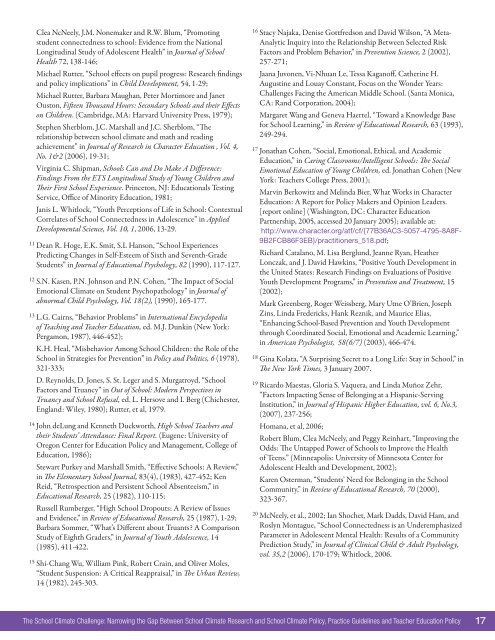The School Climate Challenge: Narrowing the Gap Between
The School Climate Challenge: Narrowing the Gap Between
The School Climate Challenge: Narrowing the Gap Between
You also want an ePaper? Increase the reach of your titles
YUMPU automatically turns print PDFs into web optimized ePapers that Google loves.
Clea NcNeely, J.M. Nonemaker and R.W. Blum, “Promotingstudent connectedness to school: Evidence from <strong>the</strong> NationalLongitudinal Study of Adolescent Health” in Journal of <strong>School</strong>Health 72, 138-146;Michael Rutter, “<strong>School</strong> effects on pupil progress: Research findingsand policy implications” in Child Development, 54, 1-29;Michael Rutter, Barbara Maughan, Peter Mortimore and JanetOuston, Fifteen Thousand Hours: Secondary <strong>School</strong>s and <strong>the</strong>ir Effectson Children. (Cambridge, MA: Harvard University Press, 1979);Stephen Sherblom, J.C. Marshall and J.C. Sherblom, “<strong>The</strong>relationship between school climate and math and readingachievement” in Journal of Research in Character Education , Vol. 4,No. 1&2 (2006), 19-31;Virginia C. Shipman, <strong>School</strong>s Can and Do Make A Difference:Findings From <strong>the</strong> ETS Longitudinal Study of Young Children and<strong>The</strong>ir First <strong>School</strong> Experience. Princeton, NJ: Educationals TestingService, Office of Minority Education, 1981;Janis L. Whitlock, “Youth Perceptions of Life in <strong>School</strong>: ContextualCorrelates of <strong>School</strong> Connectedness in Adolescence” in AppliedDevelopmental Science, Vol. 10, 1, 2006, 13-29.11Dean R. Hoge, E.K. Smit, S.L Hanson, “<strong>School</strong> ExperiencesPredicting Changes in Self-Esteem of Sixth and Seventh-GradeStudents” in Journal of Educational Psychology, 82 (1990), 117-127.12S.N. Kasen, P.N. Johnson and P.N. Cohen, “<strong>The</strong> Impact of SocialEmotional <strong>Climate</strong> on Student Psychopathology” in Journal ofabnormal Child Psychology, Vol. 18(2), (1990), 165-177.13L.G. Cairns, “Behavior Problems” in International Encyclopediaof Teaching and Teacher Education, ed. M.J. Dunkin (New York:Pergamon, 1987), 446-452);K.H. Heal, “Misbehavior Among <strong>School</strong> Children: <strong>the</strong> Role of <strong>the</strong><strong>School</strong> in Strategies for Prevention” in Policy and Politics, 6 (1978),321-333;D. Reynolds, D. Jones, S. St. Leger and S. Murgatroyd, “<strong>School</strong>Factors and Truancy” in Out of <strong>School</strong>: Modern Perspectives inTruancy and <strong>School</strong> Refusal, ed. L. Hersove and I. Berg (Chichester,England: Wiley, 1980); Rutter, et al, 1979.14John deLung and Kenneth Duckworth, High <strong>School</strong> Teachers and<strong>the</strong>ir Students’ Attendance: Final Report. (Eugene: University ofOregon Center for Education Policy and Management, College ofEducation, 1986);Stewart Purkey and Marshall Smith, “Effective <strong>School</strong>s: A Review,”in <strong>The</strong> Elementary <strong>School</strong> Journal, 83(4), (1983), 427-452; KenReid, “Retrospection and Persistent <strong>School</strong> Absenteeism,” inEducational Research, 25 (1982), 110-115;Russell Rumberger, “High <strong>School</strong> Dropouts: A Review of Issuesand Evidence,” in Review of Educational Research, 25 (1987), 1-29;Barbara Sommer, “What’s Different about Truants? A ComparisonStudy of Eighth Graders,” in Journal of Youth Adolescence, 14(1985), 411-422.15Shi-Chang Wu, William Pink, Robert Crain, and Oliver Moles,“Student Suspension: A Critical Reappraisal,” in <strong>The</strong> Urban Review,14 (1982), 245-303.16Stacy Najaka, Denise Gottfredson and David Wilson, “A Meta-Analytic Inquiry into <strong>the</strong> Relationship <strong>Between</strong> Selected RiskFactors and Problem Behavior,” in Prevention Science, 2 (2002),257-271;Jaana Juvonen, Vi-Nhuan Le, Tessa Kaganoff, Ca<strong>the</strong>rine H.Augustine and Louay Constant, Focus on <strong>the</strong> Wonder Years:<strong>Challenge</strong>s Facing <strong>the</strong> American Middle <strong>School</strong>. (Santa Monica,CA: Rand Corporation, 2004);Margaret Wang and Geneva Haertel, “Toward a Knowledge Basefor <strong>School</strong> Learning,” in Review of Educational Research, 63 (1993),249-294.17Jonathan Cohen, “Social, Emotional, Ethical, and AcademicEducation,” in Caring Classrooms/Intelligent <strong>School</strong>s: <strong>The</strong> SocialEmotional Education of Young Children, ed. Jonathan Cohen (NewYork: Teachers College Press, 2001);Marvin Berkowitz and Melinda Bier, What Works in CharacterEducation: A Report for Policy Makers and Opinion Leaders.[report online] (Washington, DC: Character EducationPartnership, 2005, accessed 20 January 2005); available at:http://www.character.org/atf/cf/{77B36AC3-5057-4795-8A8F-9B2FCB86F3EB}/practitioners_518.pdf;Richard Catalano, M. Lisa Berglund, Jeanne Ryan, Hea<strong>the</strong>rLonczak, and J. David Hawkins, “Positive Youth Development in<strong>the</strong> United States: Research Findings on Evaluations of PositiveYouth Development Programs,” in Prevention and Treatment, 15(2002);Mark Greenberg, Roger Weissberg, Mary Utne O’Brien, JosephZins, Linda Fredericks, Hank Reznik, and Maurice Elias,“Enhancing <strong>School</strong>-Based Prevention and Youth Developmentthrough Coordinated Social, Emotional and Academic Learning,”in American Psychologist, 58(6/7) (2003), 466-474.18Gina Kolata, “A Surprising Secret to a Long Life: Stay in <strong>School</strong>,” in<strong>The</strong> New York Times, 3 January 2007.19Ricardo Maestas, Gloria S. Vaquera, and Linda Muñoz Zehr,“Factors Impacting Sense of Belonging at a Hispanic-ServingInstitution,” in Journal of Hispanic Higher Education, vol. 6, No.3,(2007), 237-256;Homana, et al, 2006;Robert Blum, Clea McNeely, and Peggy Reinhart, “Improving <strong>the</strong>Odds: <strong>The</strong> Untapped Power of <strong>School</strong>s to Improve <strong>the</strong> Healthof Teens.” (Minneapolis: University of Minnesota Center forAdolescent Health and Development, 2002);Karen Osterman, “Students’ Need for Belonging in <strong>the</strong> <strong>School</strong>Community,” in Review of Educational Research, 70 (2000),323-367.20McNeely, et al., 2002; Ian Shochet, Mark Dadds, David Ham, andRoslyn Montague, “<strong>School</strong> Connectedness is an UnderemphasizedParameter in Adolescent Mental Health: Results of a CommunityPrediction Study,” in Journal of Clinical Child & Adult Psychology,vol. 35,2 (2006), 170-179; Whitlock, 2006.<strong>The</strong> <strong>School</strong> <strong>Climate</strong> <strong>Challenge</strong>: <strong>Narrowing</strong> <strong>the</strong> <strong>Gap</strong> <strong>Between</strong> <strong>School</strong> <strong>Climate</strong> Research and <strong>School</strong> <strong>Climate</strong> Policy, Practice Guidelines and Teacher Education Policy17



